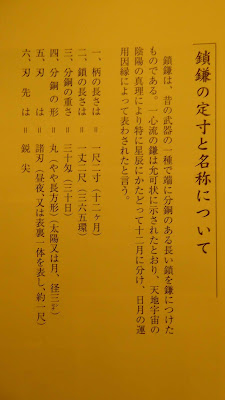The kusarigama of the Isshin Ryu is what Amdur refers to as the Type 3. According to his work the Shibukawa Ryu also uses this type, however I have not found any reference material to the construction of their weapon.
This work is mainly focussed on the chain side of the weapon, however a critical feature of this Type 3 is the position of the guard on the inside corner between the blade and the handle. Holding the sickle in this position reduces the range of the sickle even further but allows for the blade to be orientated up or down (or inside or outside) and makes ‘funnelled’ catches possible.
I plan to have a detailed look at this style so this section covers mostly the weapon itself.
Amdur describes the Isshin Ryu syllabus as a mixture of an intriguing array of very strong techniques mixed with others that seem to be a creation of someone who had clearly never fought or even sparred with the weapon against someone who was willing to hit back.
According to ShindoMusoRyu.com Isshin Ryu Kursarigamajutsu is the martial art of the Chain and Sickle. The kusarigama was integrated into the SMR curriculum by the 24th Headmaster, Shiraishi Hanjiro Shigeaki. Currently, Kaminoda Sensei holds the rank of Shihanke of Isshin Ryu Kusarigama. There are 24 kata plus six advanced kata.
There are many varieties of Kama. The kama used in Isshin Ryu is characterised by its longer chain and long, straight, double-edged steel blade. The blade is 31 centimetres long, the wooden handle is 39 centimetres, the hand-guard is made of iron, the chain is 3.6 meters long, and the weight (Fundo) is 110 grams. (The Fundo varies in weight up). There is a kama for training of the same dimensions made of wood, with a rope Himo and leather bag weight.
The subject of the Kusarigama came up briefly in an interview at which Shimizu was present, so I have added it here for interest (note the full article has a few translation problems and may not be entirely reliable):
Morikawa: Ancient Budo is actually really effective in the real life. We should really respect it. As Matsumoto-sensei said, we should try to preserve it. By the way, I would like to talk about the Kusarigama now. How heavy is the ball attached on the chain?
Kurota: About 0.25lb. However, if you get hit by this one, you will be hurt. The sickle is about 12 inches. It’s double edged. (0.25lb is 113 grams, 12” is 30.48 centimetres - consistent with the other reference).
Morikawa: How long is the chain?
Wagatsuma: About 10 feet. (10’ is 3.048 metres - less than other reference).
Morikawa: How about the rope? (Talking about the rope used in Hojojutsu, or maybe Hayanawa - 7.3’ is 2.22 meters)
Shimizu: 7.3ft.long. This is actually originally coming from Aikido and Jujutsu. Using rope is much safer to catch criminals. As we talked, handcuffs are actually not good enough. They can use it to hit people. Also, there was an accident that one guy who shot a police officer with wearing handcuffs because he was hiding a gun under his belt. Unfortunately, the policeman died. Anyways, there are so many different ways to use ropes. You can tie their hand or even arms.
In Pascal Krieger’s Jodo - Way Of The Stick (1988) he gives the following details:
The steel chain is 3.6 m long (12 Shaku, coinciding with the months of the year) and is said to have 350 links representing the days. In well-made models, the size of the links decreased as they got closer to the weight (Fundo).
This 3.6 metre length is considered very long since most Japanese sickles have chains about the length of a man's height. This shorter length meant that it was easy to control the entire chain simply by grasping the sickle handle in one hand, the chain in the other and extending the arms. The lengthy Isshin Ryu chain, on the ether hand, can be used in a flail-like fashion to distract and upset the enemy, or swung in vertical circles to keep him at a safe distance while reserving sufficient chain to attack him at any time by simply releasing the remaining links: It may be thrown to ensnarl the enemy's sword from a safe distance, and is especially important for propelling the Fundo. This metal ball weighs 113 grams and while it is most often accelerated by swinging the chain before its release, it may be thrown by hand as well. Major targets are the face and top of the head, backbone and other exposed areas.
For training purposes, a wooden Kusarigama is used, except for the guard, which is made of iron, with a rope serving as the chain. A deer skin leather ball stuffed with cotton makes it possible to actually attack one's partner for Fundo target practice, but the speed and power of even this mock weight can stun and leave welts.
Kaminoda’s detailed but untranslated work on Isshin Ryu contains the following (#2 refers to 鎖 chain):
一 ichi (one)
丈 jou (10 shaku - 3.03 metres)
二 ni (two)
尺 shaku (30.3cms)
So again the length is 12 shaku or 3.636 metres.
This photo is taken from the Isshin Ryu book by Kaminoda. Note the dual edged blade. Also note the method of attachment at either end of the chain, the link and weight size (if you are thinking of making one).
The practice weapon.





